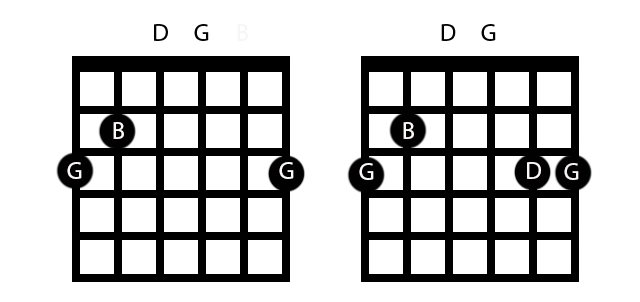Play More of the Music by Playing Solo Guitar
Solo guitar melody arrangements are a fun and satisfying way to play more of the music by yourself.
Working up an arrangement also helps pull all your guitar knowledge together. The process of arranging a song is a series of choices: which chords to fit to the melody, and how to voice them on guitar. This requires some knowledge of theory and of the fretboard!
Let’s start with establishing three basic principles:
- A melody is a sequence of notes expressed over time.
- Notes of the melody will belong to (and often imply) the underlying chords.
- There are always multiple ways to harmonize a melody, by varying the chords and when they change.
We also should establish that a basic major or minor chord contains just three notes.
Many guitar chords contain four, five, or six notes, in which notes are doubled at the octave. For example, a familiar open position C major chord contains the three notes of a C triad, C-E-G, and adds another C and E an octave higher:
The G major triad is G-B-D, but a familiar open G chord has three G’s, and doubles either the B or the D depending on the fingering:
In the next example below, it’s easy to hear how the opening C chord blends with the starting melody note C.
Note how the same chord blends equally well with the third and fifth tones of the series, E and G, because a C triad also contains those two notes as well. So we might say that the C chord harmonizes with the notes C, E, and G. The scale segment therefore contains the notes of the C chord plus two passing tones, connecting steps between chord tones.
C d E f G
The D and F notes do NOT belong to the C chord. So technically they should clash, but they fall on between the chord tones on the weak beats. So the entire scale segment fits the C chord, even though it contains notes that don’t belong to the chord.
Note that the second bar substitutes a different chord on the 5th tone, G. It should be no surprise that a G chord would fit a G note, of course, and in the key of C we would then refer to it as a 5 chord. This is a tension, an open-ended question that demands a resolution. Think of the 5 chord as a musical comma, setting up expectation for the next phrase.
Since the same note can appear in more than one chord, we’re not even obligated to start with a C chord to match the C note.
Remember our basic chord theory in its simplest form. To find a triad, pick a note and then skip a letter twice:
A C E
B D F
C E G
Etc.
Of course, you may need to adjust for sharps and flats, and this is why learning key signatures is so helpful. Over time, learning multiple songs in the same key will help you remember. In this case, we’re in C, so there are no accidentals needed:
C D E F G A B C
Looking at this, you might notice that the note C is a third above A. In other words, if A is note one, C is note 3 in the sequence: the third of the chord. This implies an A minor chord, and gives us the opportunity to reharmonize the first note:
Notice how in the second bar, the same C note is now reharmonized by an F chord. So the note C fits the C, Am, AND F, chords because it forms the root, third, and fifth respectively.
You might also notice that in the second half of this bar, the F is used to harmonize an E. While this might seem odd at first, look at the notes of an F triad, F – A – C. If we continue the pattern and skip ANOTHER note, we get F – A – C – E, or an Fmaj7.
This opens up an entire new set of possibilities, because now we know that a single note can comfortably belong to at least four chords!
If you’re up for a challenge, check out this fun example of how substituting diatonic chords can make a familiar melody sound very different. Note the use of chords like Ab, E7, and Eb, none of which belong to the key of C – but all contain at least one note that does. So the unusual chords fit but in a very unexpected way! Have fun.
Interested in more guitar lessons and courses? Check out JamPlay.com. JamPlay has over 450 guitar courses from 120+ instructors, and online guitar lessons tailored to every skill level, music genre, and playing style. Click here to learn more.
Dave Isaacs has established himself as a guitar teacher extraordinaire, having built a strong set of educational curriculums for beginner, intermediate, and advanced guitar players alike. Dave shares his expertise largely through video platforms, but also through his thoughtful writing. You can take guitar lessons from Dave Isaacs via his comprehensive video guitar courses on JamPlay.com.
Share this
Become a JamPlay member for unlimited access to 7000+ guitar lessons and 120+ artists and instructors. View membership plans ›








